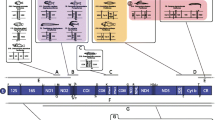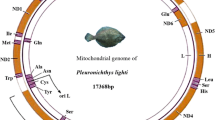Abstract
The sequence of the mitochondrial DNA (mtDNA) molecule of the blue whale (Balaenoptera musculus) was determined. The molecule is 16,402 by long and its organization conforms with that of other eutherian mammals. The molecule was compared with the mtDNA of the congeneric fin whale (B. physalus). It was recently documented that the two species can hybridize and that male offspring are infertile whereas female offspring may be fertile. The present comparison made it possible to determine the degree of mtDNA difference that occurs between two species that are not completely separated by hybridization incompatibility. The difference between the complete mtDNA sequences was 7.4%. Lengths of peptide coding genes were the same in both species. Except for a small portion of the control region, disruption in alignment was usually limited to insertion/deletion of a single nucleotide. Nucleotide differences between peptide coding genes ranged from 7.1 to 10.5%, and difference at the inferred amino acid level was 0.0–7.9%. In the rRNA genes the mean transition difference was 3.8%. This figure is similar in degree to the difference (3.4%) between the 12S rRNA gene of humans and the chimpanzee. The mtDNA differences between the two whale species, involving both peptide coding and rRNA genes, suggest an evolutionary separation of ⩾5 million years. Although hybridization between more distantly related mammalian species may not be excluded, it is probable that the blue and fin whales are nearly as different in their mtDNA sequences as hybridizing mammal species may be.
Similar content being viewed by others
References
Anderson S, Bankier AT, Barrell BG, de Bruijn MHL, Coulson AR, Drouin J, Eperon IC, Nierlich DP, Roe BA, Sanger F, Schreier PH, Smith AJH, Staden R, Young IG (1981) Sequence and organization of the human mitochondrial genome. Nature 290:457–465
Anderson S, de Bruijn MHL, Coulson AR, Eperon IC, Sanger F, Young IG (1982) Complete sequence of bovine mitochondrial DNA. Conserved features of the mammalian mitochondrial genome. J Mol Biol 156:683–717
Árnason Ú (1974) Comparative chromosome studies in Cetacea. Hereditas 77:1–36
Árnason Ú, Bellamy H, Eythórsson Th, Lutley R, Sigurjónsson J, Widegren B (1985) Hereditas 102:251–253
Árnason Ú, Widegren B (1989) Composition and chromosomal localization of cetacean highly repetitive DNA with special reference to the blue whale, Balaenoptera musculus. Chromosoma 98:323–329
Árnason Ú, Gullberg A, Widegren B (1991) The complete nucleotide sequence of the mitochondrial DNA of the fin whale, Balaenoptera physalus. J Mol Evol 33:556–568
Árnason Ú, Spilliaert R, Pálsdóttir Á, Árnason A (1991a) Molecular identification of hybrids between the two largest whale species, the blue (Balaenoptera musculus) and the fin whale (B. physalus). Hereditas 115:183–189
Árnason Ú, Johnsson E (1992) The complete mitochondrial DNA sequence of the harbor seal, Phoca vitulina. J Mol Evol 34:493–505
Árnason Ú, Gullberg A, Johnsson E, Ledje C (1993) The nucleotide sequence of the mitochondrial DNA molecule of the grey seal, Halichoerus grypus, and a comparison with mitochondrial sequences of other true seals. J Mol Evol 37:323–330
Árnason Ú, Gullberg A, Widegren B (1993a) Cetacean mitochondrial control region: sequences of all extant baleen whales and two sperm whale species. Mol Biol Evol (in press)
Attardi G, Chomyn A, Doolittle RF, Mariottini P, Ragan CI (1986) Seven unidentified reading frames of human mitochondrial DNA encode subunits of the respiratory chain NADH dehydrogenase. Cold Spring Harbor Symp Quant Biol LI: 103–114
Bibb MJ, Van Etten RA, Wright CT, Walberg MW, Clayton DA (1981) Sequence and gene organization of mouse mitochondrial DNA. Cell 26:167–180
Brown WM, Prager EM, Wang A, Wilson AC (1982) Mitochondrial DNA sequences of primates: tempo and mode of evolution. J Mol Evol 18:225–239
Brown GG, Simpson MV (1982) Novel features of animal mtDNA evolution as shown by sequences of two rat cytochrome oxidase subunit 11 genes. Proc Natl Acad Sci USA 79:3246–3250
Cann RL, Brown WM, Wilson AC (1984) Polymorphic sites and the mechanism of evolution in human mitochondrial DNA. Genetics 106:479–499
Devereux J, Haeberli P, Smithies O (1984) A comprehensive set of sequence analysis programs for the VAX. Nucleic Acids Res 12:387–395
Gadaleta G, Pepe G, De Candia G, Quagliariello C, Sibisa E, Saccone C (1989) The complete nucleotide sequence of the Rattus norvegicus mitochondrial genome: cryptic signals revealed by comparative analysis between vertebrates. J Mol Evol 28:497–516
Gray AP (1972) Mammalian hybrids. Commonwealth Agricultural Bureaux, Slough, GB
Gribskov M, Burgess RR (1986) Sigma factors from E. coli, B. subtilis, phage SPO1, and phage T4 are homologous proteins. Nucleic Acids Res 14(16):6745–6763
Haldane JBS (1922) Sex ratio and unisexual sterility in hybrid animals. J Genet 12:101–109
Hayasaka K, Gojobori T, Horai S (1988) Molecular phylogeny and evolution of primate mitochondrial DNA. Mol Biol Evol 5:626–644
Hill A, Ward S (1988) Origin of the hominidae: the record of African large hominoidae evolution between 14 MY and 4 MY. Yearb Phys Anthropol 31:49–83
Hixson JE, Brown WM (1986) A comparison of the small ribosomal RNA genes from the mitochondrial DNA of the great apes and humans: sequence, structure, evolution and phylogenetic implications. Mol Biol Evol 3:1–18
Irwin DM, Kocher TD, Wilson AC (1991) Evolution of the cytochrome b gene of mammals. J Mol Evol 32:128–144
Kraus F, Miyamoto MM (1991) Rapid cladogenesis among the pecoran ruminants: evidence from mitochondrial DNA sequences. Syst Zool 40:117–130
Miyamoto MM, Boyle SM (1989) The potential importance of mitochondrial DNA sequence data to eutherian mammal phylogeny. In: Fernholm B, Bremer K, Jörnvall H (eds) The hierarchy of life. Elsevier, Amsterdam, pp 437–450
Miyamoto MM, Kraus F, Ryder OA (1990) Phylogeny and evolution of antlered deer determined from mitochondrial DNA sequences. Proc Natl Acad Sci USA 87:6127–6131
Okimoto R, Macfarlane JL, Wolstenholme DR (1990) Evidence for the frequent use of TTG as the translation initiation codon of mitochondrial protein genes in the nematodes, Ascaris suum and Caenorhabditis elegans. Nucleic Acids Res 18: 6113–6118
Ramharack R, Deeley RG (1987) Structure and evolution of primate cytochrome c oxidase subunit II gene. J Biol Chem 262:14014–14021
Ruvolo M, Disotell TR, Allard MW, Brown WM (1991) Resolution of the African hominoid trichotomy by use of a mitochondrial gene sequence. Proc Natl Acad Sci USA 88:1570–1574
Sanger F (1981) Determination of nucleotide sequences in DNA. Science 214:1205–1210
Savage DE, Russell DE (1983) Mammalian paleofaunas of the world. Addison-Wesley, Reading, MA
Spilliaert R, Víkingsson G, Árnason Ú, Pálsdóttir Á, Sigurjónsson J, Árnason A (1991) Species hybridication between a female blue whale (Balaenoptera musculus) and a male fin whale (B. physalus): molecular and morphological documentation. J Hered 82:269–274
Sylvestre JP, Tasaka S (1985) On the intergeneric hybrids in cetaceans. Aquat Mamm 11:101–108
Vigilant L, Pennington R, Harpending H, Kocher TD, Wilson CA (1989) Mitochondrial DNA sequences in single hairs from a southern African population. Proc Natl Acad Sci USA 86: 9350–9354
Vigilant L, Stoneking M, Harpending H, Hawkes K, Wilson CA (1991) African populations and the evolution of human mitochondrial DNA. Science 253:1503–1507
Wada S, K-i Numachi (1991) Allozyme analyses of genetic differentiation among the populations and species of the Balaenoptera. Rep Int Whal Comm Spec Issue 13:125–154
Author information
Authors and Affiliations
Additional information
Correspondence to: Ú. Árnason
Rights and permissions
About this article
Cite this article
Árnason, Ú., Gullberg, A. Comparison between the complete mtDNA sequences of the blue and the fin whale, two species that can hybridize in nature. J Mol Evol 37, 312–322 (1993). https://doi.org/10.1007/BF00178861
Received:
Revised:
Issue Date:
DOI: https://doi.org/10.1007/BF00178861




